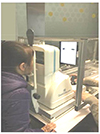Abstract
Purpose
Methods
Results
Figures and Tables
Figure 1
Measurement of refraction using an open-field autorefractor b (WAM-5500, Grand Seiko, Tokyo, Japan). Measuring both distance and near refraction allowed us to calculate the degree of near accommodation.

Figure 2
Eye tracking test using the SMI Eye Tracking Glasses 2 Wireless (Sensory Motoric Instruments, Teltow, Germany). Fixation was continuously traced while watching videos.

Table 1
Demographics of subjects

Values are presented as mean ± SD unless otherwise indicated. ‘Group A’ means ‘subjects watching control video after test video with a 30-minute-intermission’ and ‘Group B’ means ‘subjects watching test video after control video with a 30-minute-intermission’. Myopia was defined when the myopic refractive error was −1.0 diopter or greater. Hyperopia was defined when the refractive error was higher than 0 diopter.
OD = right eye; OS = left eye.
Table 3
Monocular accommodation responses after watching control and test video (diopters)

‘Group A’ means ‘subjects watching control video after test video with a 30-minute-intermission’ and ‘Group B’ means ‘subjects watching test video after control video with a 30-minute-intermission’. Myopia was defined when the myopic refractive error was −1.0 diopter or greater. Hyperopia was defined when the refractive error was higher than 0 diopter.
*2-tailed paired t-test; †Repeated measured analysis of variance (ANOVA).




 PDF
PDF ePub
ePub Citation
Citation Print
Print




 XML Download
XML Download